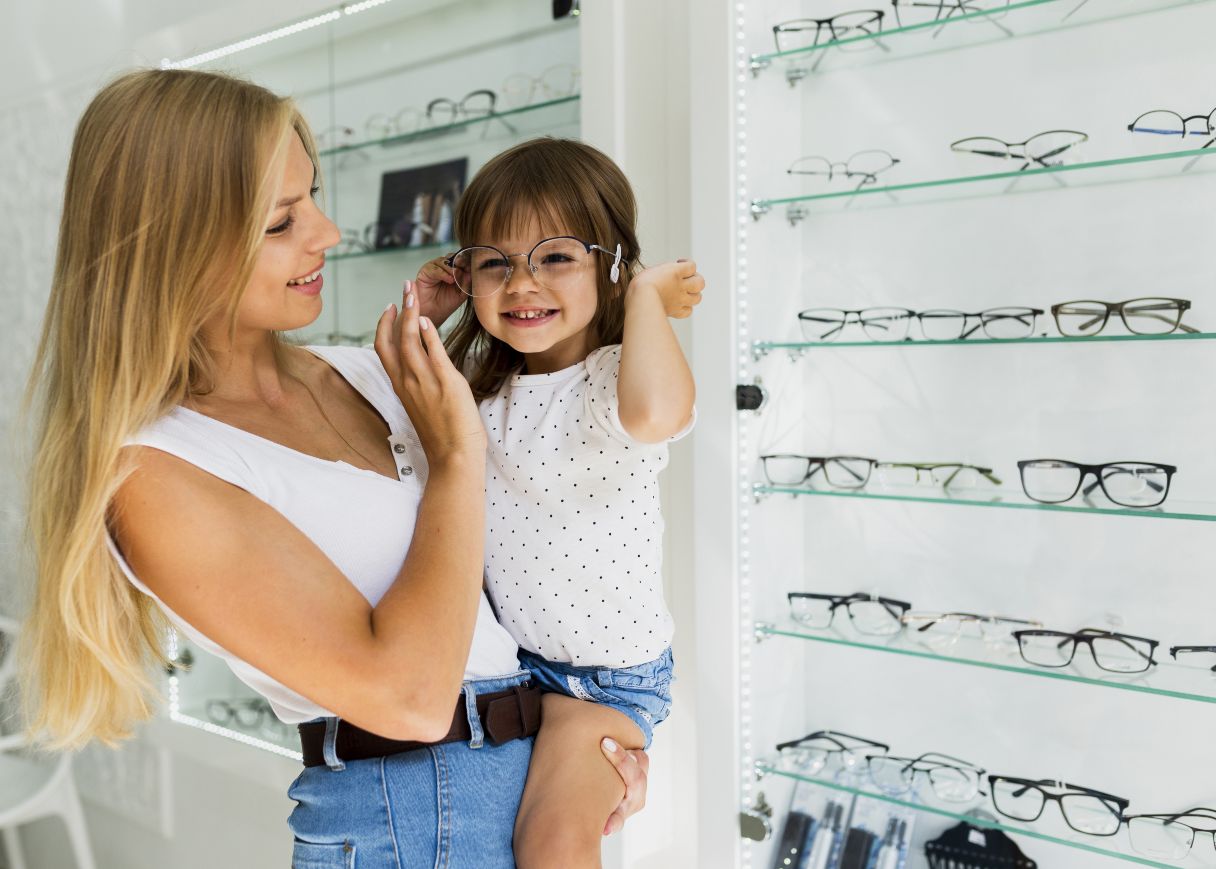Do you suspect your child might need glasses? Vision issues in kids can go undiagnosed, especially since children often assume everyone sees the world the same way they do.1
Many vision problems develop gradually, making them easy to miss without a proper screening. And since young children may not have the words to explain what they’re experiencing, the signs of poor vision can often be mistaken for behavioral or learning issues.1
Understanding Children’s Eye Health
Because good vision is essential for learning, social development and overall well-being, routine eye exams for children are a must.2 Common vision problems that can begin to develop in childhood include:1
- Astigmatism (blurred or distorted vision)
- Nearsightedness (difficulty seeing far away)
- Farsightedness (trouble seeing up close)
Signs Your Child May Need Eyeglasses
Kids may not always realize their vision isn’t normal, so it’s important to watch for key signs and behaviors that may indicate an issue. Follow up with your eye doctor for a complete exam to see if your child needs corrective eyewear.
Some of these behaviors include:1
- Avoiding visually intense activities2
- Clumsiness
- Complaining of headaches, tired eyes or fatigue
- Difficulty concentrating
- Difficulty keeping their place on a page or skipping lines while reading
- Frequent eye rubbing
- Head tilting
- Poor reading comprehension2
- Sitting very close to the board, TV or screen, or holding a book very close to their face2
- Squinting
Untreated vision problems in children can lead to difficulties with reading, writing, concentration and social interactions.2 Regular eye exams can help with early detection of vision issues, where prompt treatment can make a significant difference in your child’s learning and overall development.1
When Should Children Get Their Eyes Checked?
The American Optometric Association® recommends that a child have their first comprehensive eye exam at 6 months of age, another around age 3 and again before starting school, around age 5. After that, unless advised otherwise, kids should have an eye exam every two years to monitor their vision as they grow.1
Note that vision screenings at school or a pediatrician’s office are not the same as a comprehensive eye exam.1 Vision screenings can help diagnose common eye problems like nearsightedness, farsightedness and astigmatism.1 But a comprehensive eye exam will also assess other important aspects that a vision screening can miss, such as how well the eyes work together, depth perception and peripheral vision, focus ability and color blindness.3 In addition, a comprehensive eye exam will assess the overall health and development of the eye’s inner structures, like the retina, optic nerve and lenses.3
Keep your child on the recommended eye exam schedule, but see your eye doctor for additional care if they suffer an eye injury or begin exhibiting signs of vision problems like squinting or headaches. Inform your eye doctor if there’s a family history of eye conditions such as lazy eye, severe refractive errors or genetic eye diseases.2
Choosing the Right Glasses for Your Child
Your child’s vision may change rapidly as they grow and develop, so getting an accurate prescription from your eye doctor to ensure your child will be able to see with precision is a priority.4
Fit, comfort and durability are other key factors when choosing eyewear for kids. Consider the following:
1. Pick the right-sized frame
Glasses should be proportional in size to your child’s face, not too big or small, and sit snugly on the bridge of their nose without slipping. The temples (arms of the glasses) should fit securely around the ears without pinching or pressure, so the glasses stay in place during your child’s activities.5
2. Material matters
Glasses made from lightweight, flexible and hypoallergenic material are gentle on sensitive skin and long-lasting for everyday wear.5 Rubberized frames are durable, come in a variety of colors and provide a good fit.4
3. Opt for safe lenses
Prioritize safety with impact-resistant polycarbonate or Trivex® lenses, which are tougher than regular plastic and can help protect your child’s eyes during sports or other activities. Additionally, these lenses filter UV rays and can come with a scratch-resistant coating.4
4. Help them pick frames they love
Your child may be more likely to consistently wear their glasses if they’re able to choose a style that suits their personality and lets them express themselves. Let your child explore a variety of shapes, colors, patterns and kid-friendly styles when picking out their frames.5
5. Consider comfort
Getting the right fit is important when you’re dealing with growing faces. An optometrist will work with the shape of your child’s face as well as their lens diameter, bridge width of the nose and temple length to suggest the right size and style of glasses for your child, as well as their lifestyle.6
Most kids get used to their new glasses within a couple of weeks. If your child complains of discomfort, ear or nose pain, work with your eye doctor for an adjustment to the frames. They’ll want to make sure that the frames will cover at least 80% of your child’s field of vision and that the arms are not too tight against their head. Nose pads shouldn’t be too heavy or dig into the side of your child’s nose, and the glasses shouldn’t slip forward if your child bends their head.7
Getting an adjustment after a few weeks of wear can be a good way to help ensure well-fitting, comfortable frames and increase the likelihood that your child will wear their glasses as prescribed.
How to Care for Your Child’s Glasses
Your child’s eyeglasses are an investment, and no doubt you want them to stay in good condition. Teaching your kids to handle their glasses with care takes time and patience, but instilling good habits early will help ensure their glasses remain in good condition.8
1. Teach your kids how to handle, clean and store their glasses
Remind your child to use two hands when putting on or taking off their glasses, which reduces stress on the arms and hinges. They should close both arms and lay the glasses lens up, never lens down, on a hard surface. Discourage kids from wearing their glasses as a headband when not in use, which can warp the frames. When they’re not wearing them, kids should store their glasses in a hard-sided case to prevent scratches, warping or cracked frames.8
Clean eyeglasses by first rinsing them in lukewarm water to remove dust or debris that could scratch the lenses. Add a drop of mild dish soap to each lens and gently rub with clean fingers, including the front and back of the lens, nose pieces, and arms. Rinse and dry the lenses with a microfiber or lint-free towel. Never use clothing, paper towels or tissues for cleaning, which can scratch the lenses.8
2. Invest in a spare pair
Having an extra pair of glasses, especially if your child has a strong prescription and needs their glasses for everyday use, can be advantageous if their primary pair becomes damaged or lost. Ask your eye doctor if they offer a discount if you purchase a spare pair.4
3. Schedule regular adjustments and checkups
Daily wear and tear on a child’s eyeglasses takes its toll. It’s a good idea to schedule regular appointments with your child’s eye doctor to have their glasses inspected, realigned or adjusted to ensure a good fit. Your eye doctor can also check to make sure the eyeglass prescription is still appropriate for their vision needs.8
4. Address lost or broken glasses quickly
Parents can tighten loose screws with an eyeglass repair kit, but contact your eye doctor for professional repair if the frame becomes bent or distorted, the hinges are broken or the lenses are scratched or cracked. Fix these issues promptly, as wearing misaligned glasses or going without can affect your child’s ability to navigate their daily life safely and successfully.8
When to Seek Professional Advice
Even with the perfect pair of glasses, it’s important to check in with your child’s eye doctor if you notice changes in your child’s vision or eye health.8 Behavior such as squinting, holding books closer than usual, tilting their head or frequent headaches could signal that their prescription needs to be updated or that another vision issue has developed.1
If your child complains of discomfort, eye pain or blurry vision while wearing their glasses, it may indicate that the lenses need to be adjusted or the frames might no longer fit correctly.8 Suddenly refusing to wear their glasses altogether could mean they’re experiencing discomfort or visual strain, or simply dislike how the glasses feel or look.
Address these issues with professional guidance so that necessary adjustments can be made to keep your child’s eyes healthy and their vision clear.
Clear Vision for a Bright Future
Recognizing the signs that your child might need glasses can help diagnose and address vision problems early, before they affect their learning and development. Choose glasses based on fit, comfort, durability and styles your child will love to wear. With regular eye exams and the right eyewear, you can support your child’s success as they grow.
Financing Eyewear With the CareCredit Credit Card
Whether you’re purchasing stylish new frames, getting contacts or due for an eye exam, the CareCredit credit card can help you pay for care where your insurance leaves off.* Use our Acceptance Locator to find a vision specialist near you that accepts CareCredit so you can see all that life has to offer. Continue your wellness journey by downloading the CareCredit Mobile App to manage your account, find a provider on the go and easily access the Well U blog for more great articles, podcasts and videos.
In addition to vision care, you can also use your CareCredit credit card for dentistry, cosmetic, pet care, hearing, health systems, dermatology, pharmacy purchases, spa treatments and so much more within the CareCredit network. How will you invest in your health and wellness next?
Author Bio
Anne-Marie Kennedy is a freelance writer with more than 20 years of experience covering health and wellness, personal finance and real estate/investing.







